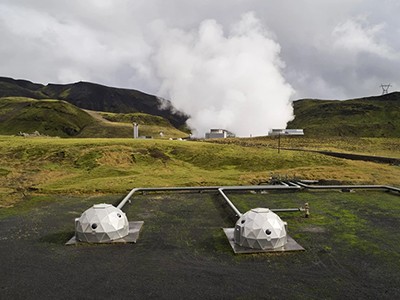Carbon dioxide removal (CDR) is what puts the ‘net’ into ‘net zero emissions’. All pathways to limit global warming to 1.5–2 °C above pre-industrial levels that have been assessed by the Intergovernmental Panel on Climate Change require rapid decarbonization to start now. But they also require the removal of CO2 from the atmosphere because we won’t be able to eliminate carbon emissions entirely on the required time scales. ‘Hard to abate’ sectors such as aviation and shipping will remain large sources of greenhouse gases even in the most optimistic scenarios. Residual emissions will mean that we cannot achieve a zero-emissions goal, and we will need CDR to reach a net-zero target. Historically, this has meant planting or maintaining trees, but removing CO2 from the atmosphere and storing it in the ground, the ocean or in products will be more durable.
However, businesses are springing up that promise various CDR techniques as climate solutions for today. Others are enthusiastically buying carbon credits — essentially, investments in planting trees, or other future CDR capacity — as part of their current decarbonization commitments.
I have spent my career studying the natural carbon cycle and, in recent years, developing methods for checking that CDR works. I have scrutinized dozens of proposals, and I was a reviewer for the US$100-million XPRIZE Carbon Removal competition funded by the Musk Foundation. I don’t deny the need to develop CDR methods over the longer term. And I welcome governments committing much-needed resources to this area. After some small-scale demonstrations of ‘direct air capture’ (DAC) technology, which suck CO2 out of the atmosphere by chemical means, the 2022 US Bipartisan Infrastructure Law has devoted $3.5 billion to developing four DAC hubs. But it’s clear to me that deploying them to remove CO2 from the atmosphere is pointless until society has almost completely eliminated its polluting activities.
Time travel
To understand why, think of CDR as a time machine. Take the proposed US DAC hubs, for example. Each facility is eventually expected to extract one million tonnes of CO2 each year.
Carbon capture nets 2 billion tonnes of CO2 each year — but it’s not enough
In 2022, the world emitted 40.5 billion tonnes of CO2 (P. Friedlingstein et al. Earth Syst. Sci. Data 14, 4811–4900; 2022). At that rate, for every year of operation at its full potential, each hub would take the atmosphere back in time by almost 13 minutes, but in the time it took to remove those 13 minutes of CO2, the world would have spewed another full year of CO2 into the atmosphere.
Meanwhile, if everyone on Earth planted a tree — 8 billion trees — it would take us back in time by about 43 hours every year, once the trees had matured.
The time-machine analogy reveals just how futile CDR currently is.
We have to shift the narrative as a matter of urgency. Money is going to flood into climate solutions over the next few years, and we need to direct it well. We must stop talking about deploying CDR as a solution today, when emissions remain high — as if it somehow replaces radical, immediate emission cuts.
Back to the future
It’s a different story if we successfully decarbonize enough in the coming 20–30 years.
If we reduced emissions to around 10% of current levels — 4 billion tonnes of CO2 a year — a DAC plant capable of removing one million tonnes would be a time machine taking us back just over 2 hours instead of 13 minutes. At that point, it would take 4,000 facilities to reach net zero in any given year, presuming they were fully powered by renewable energy.
Net-zero emissions targets are vague: three ways to fix
In reality, residual emissions will probably be 18% of our current total (H. J. Buck et al. Nature Clim. Change https://doi.org/j4jg; 2023), so we will have to scale up CDR substantially to reach net zero. Still, it might be feasible to build 7,290 DAC hubs or deploy other CDR technology.
In the meantime, research is needed to seek CDR methods that minimize land use and energy consumption, and can be scaled up rapidly and cheaply. Doing that now is essential, so that we have the technology available in the future, when it will be effective, and when it can be used to remove legacy emissions to address intergenerational justice.
Not all techniques that work in the laboratory will work in the real world. Some might come with heavy costs for biodiversity and the environment. Developing methods to verify that CDR works is a major challenge. It will be many years before we have the science to tell us which methods work and whether they harm or benefit the environment.
Humanity has never removed an atmospheric pollutant at a global, continental or, even, regional scale — we have only ever shut down the source and let nature do the clearing up. This is the case for chlorofluorocarbons and stratospheric ozone destruction, for sulfur dioxide and acid rain, and for sulfur and nitrogen oxides and photochemical smog. We must be prepared for CDR to be a failure, leaving us to rely on the environment to stabilize atmospheric CO2 over thousands of years. This is another argument for rapid decarbonization.
The scale of the challenge is immense. We must slow the carbon clock to a crawl before we can turn it back.
Competing Interests
The author declares no competing interests.









More News
Judge dismisses superconductivity physicist’s lawsuit against university
Future of Humanity Institute shuts: what’s next for ‘deep future’ research?
Star Formation Shut Down by Multiphase Gas Outflow in a Galaxy at a Redshift of 2.45 – Nature